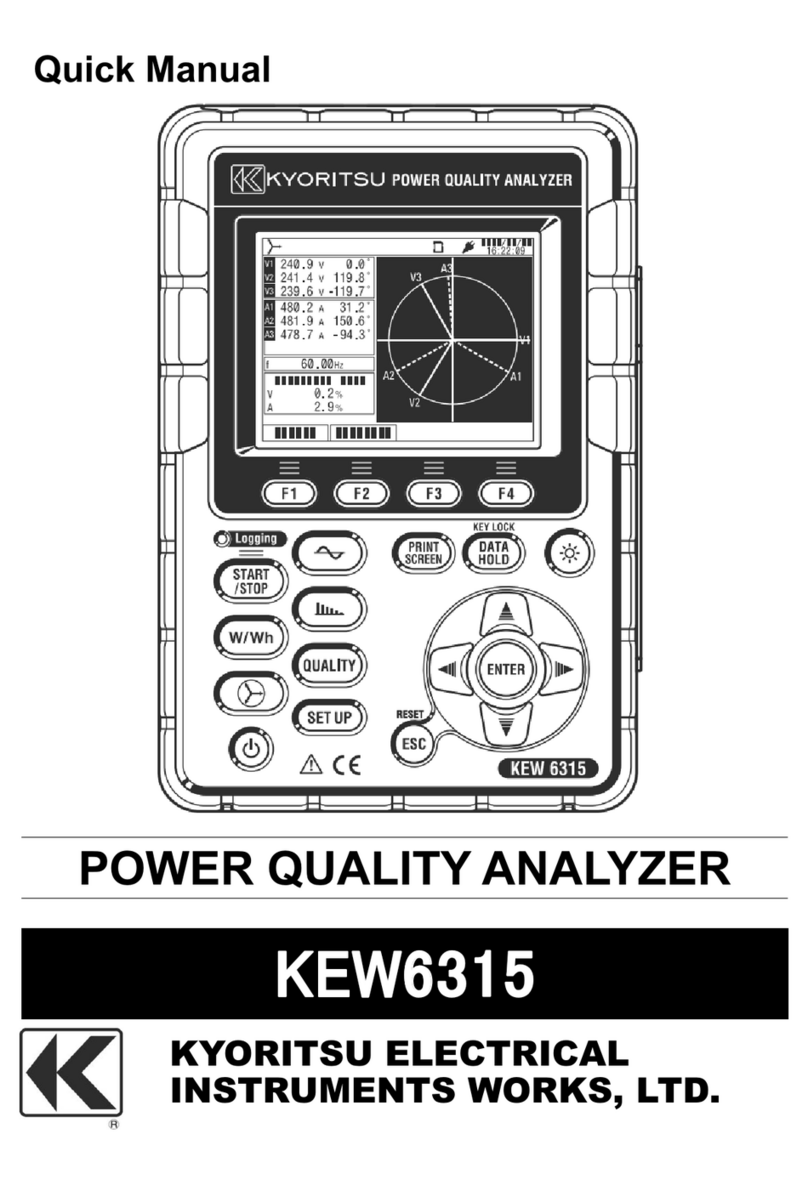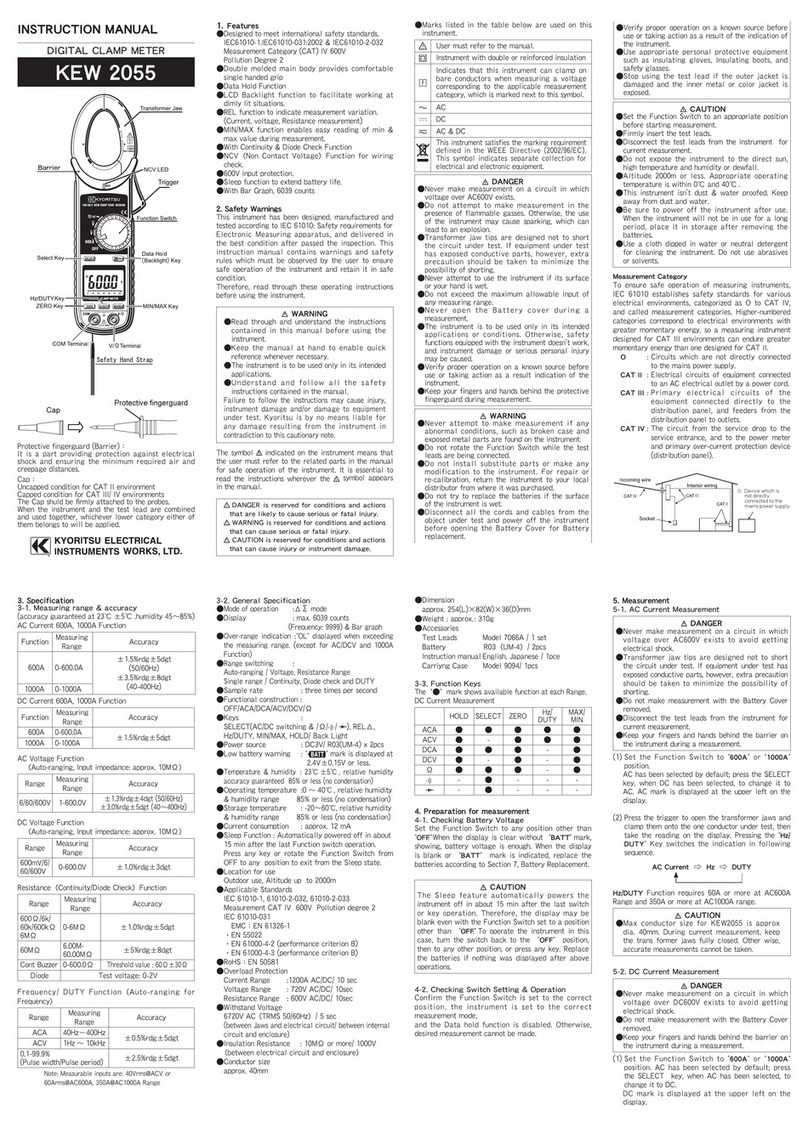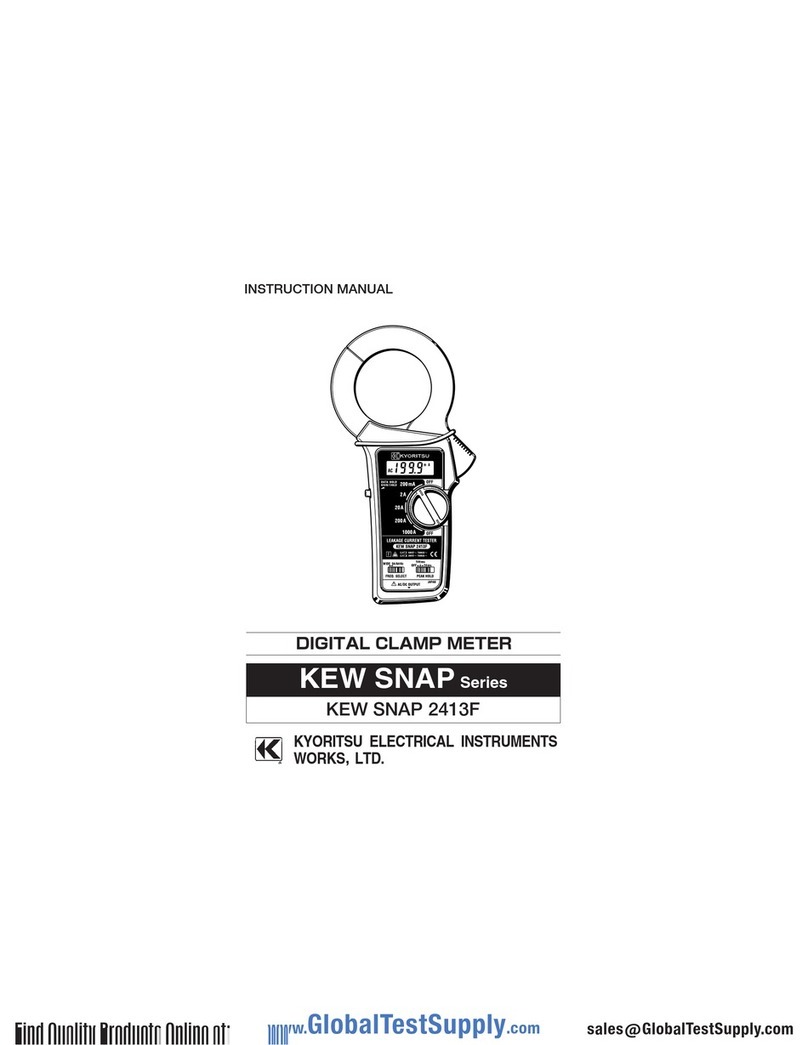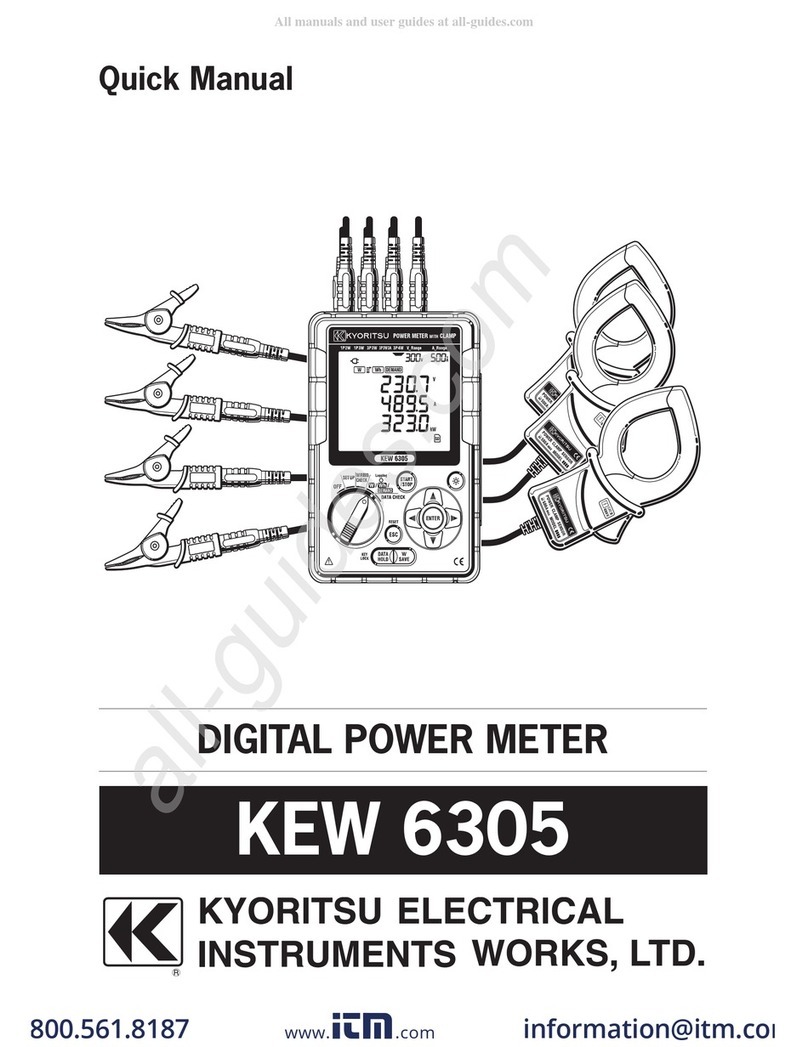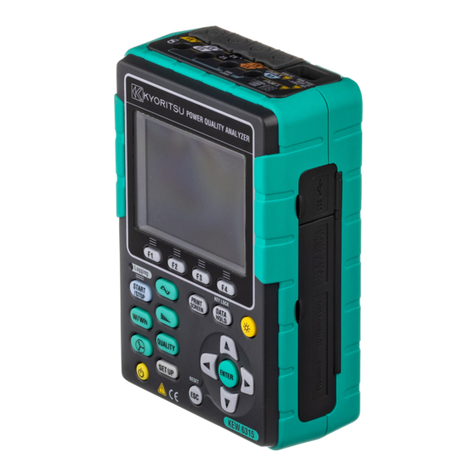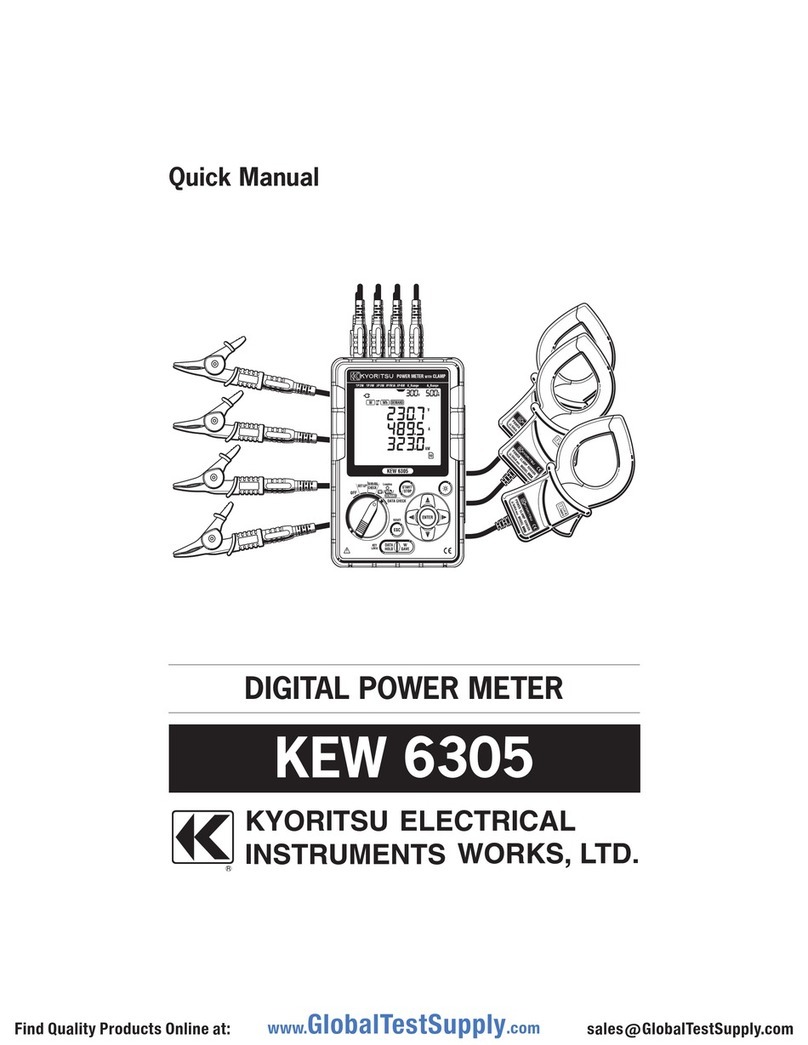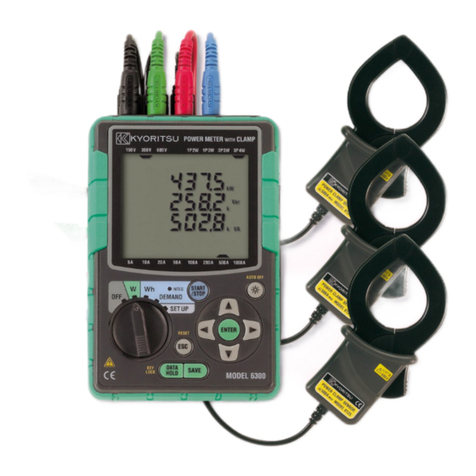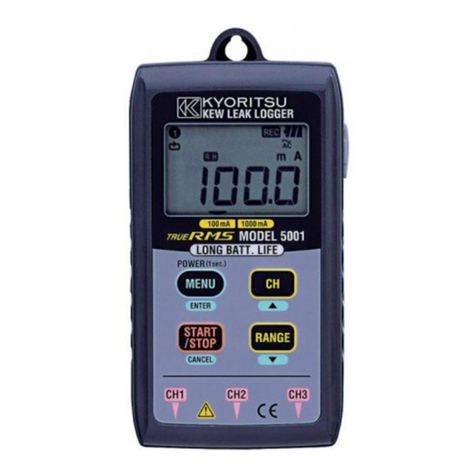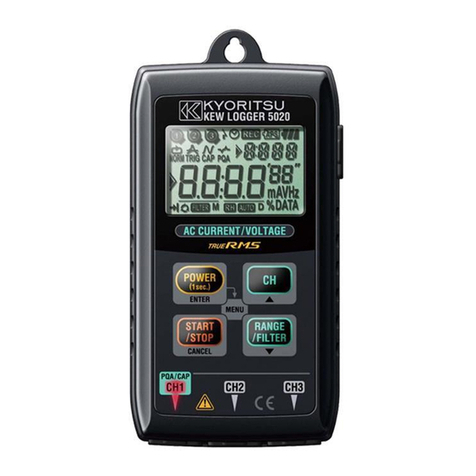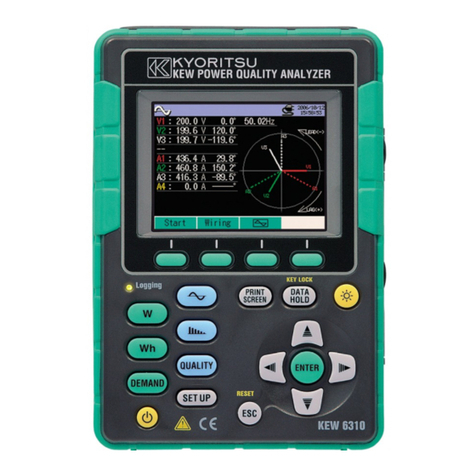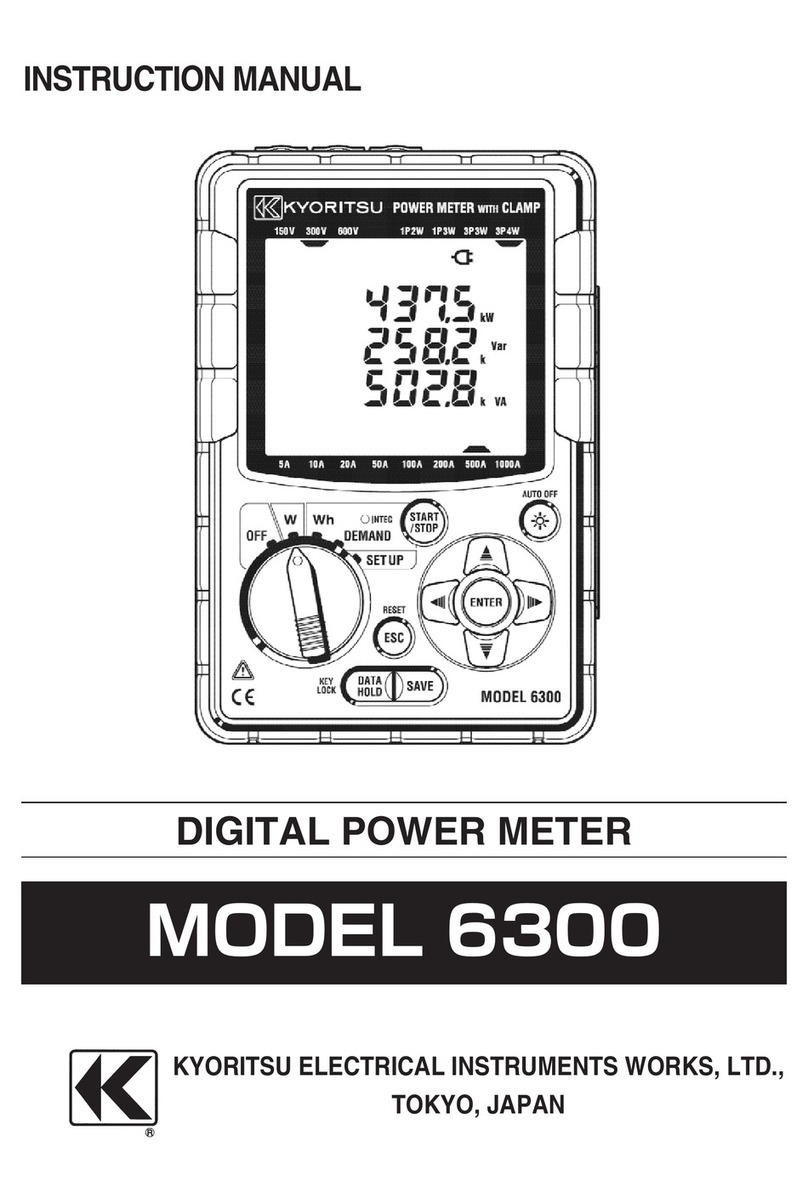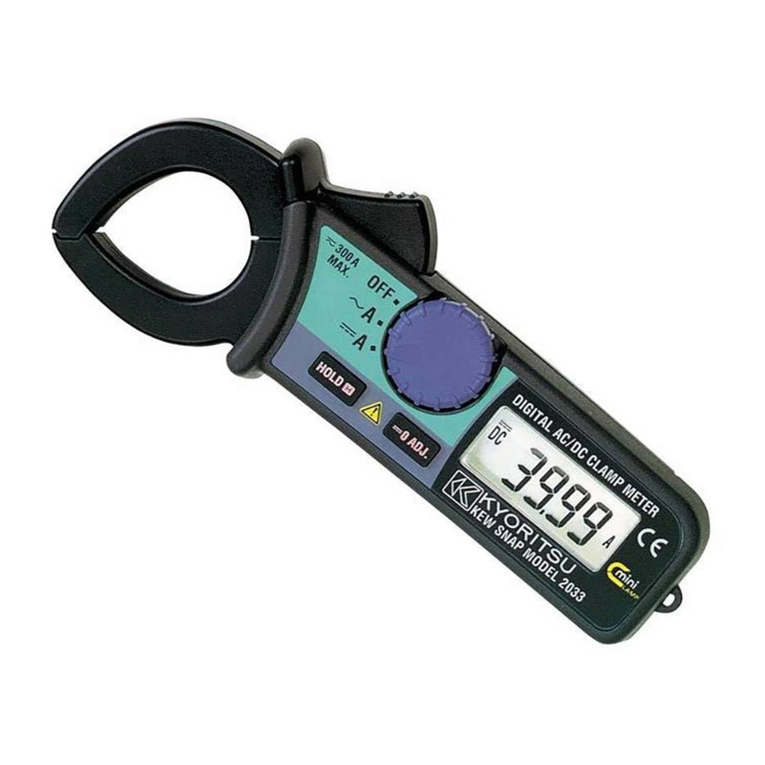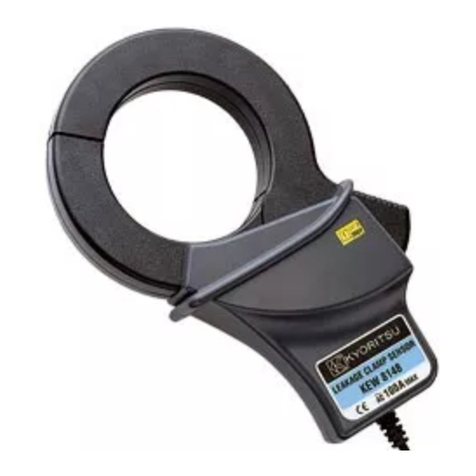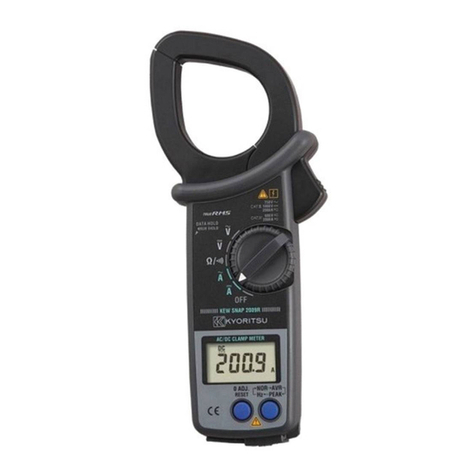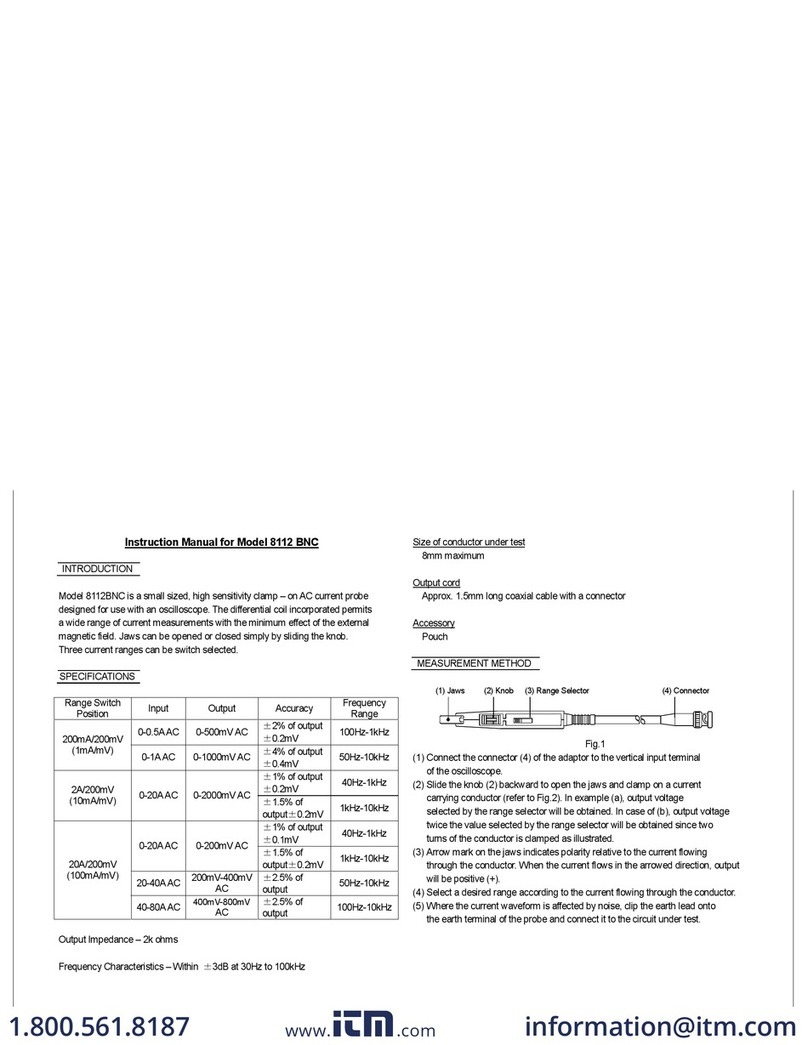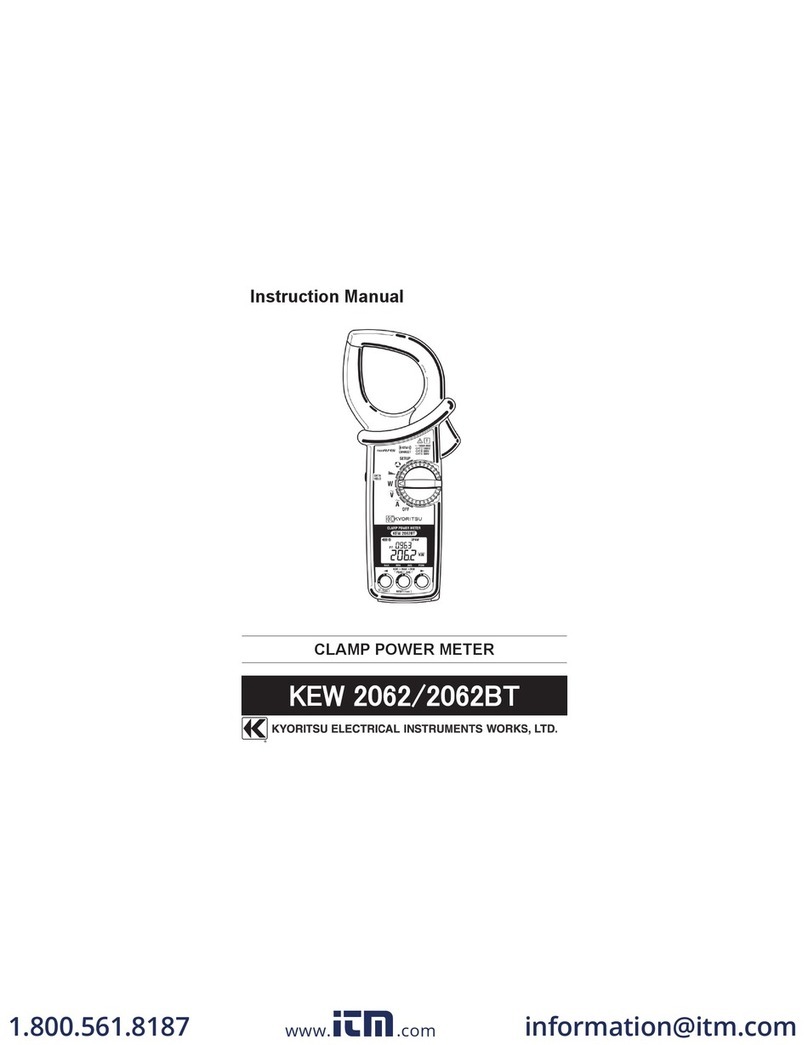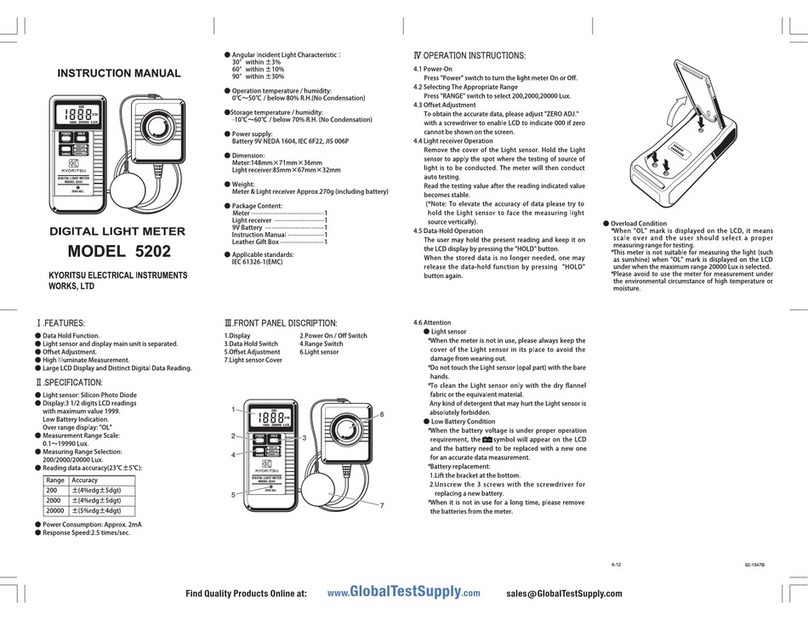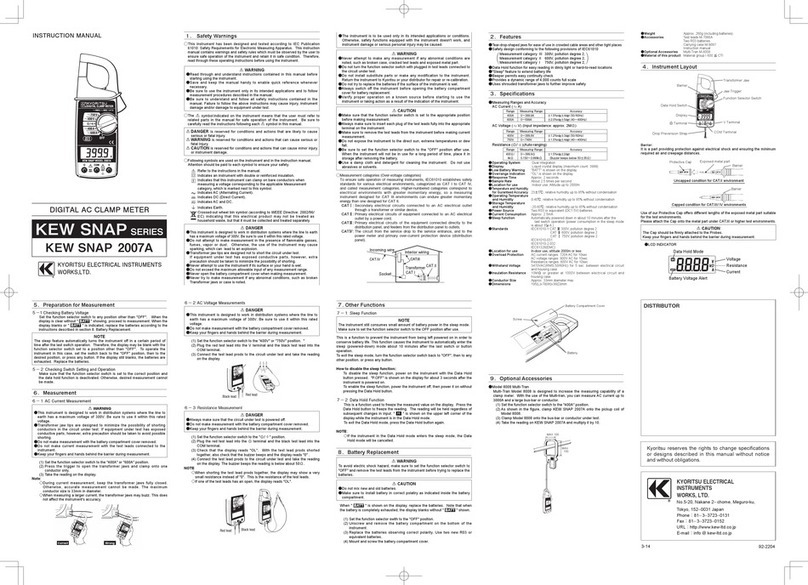
INSTRUCTIONMANUAL
DIGITALACLEAKAGECLAMPMETER
JawTrigger RangeSwitch
DataHoldButton
TransformerJaws
Display
FrequencySelectorSwitch
KEWSNAP2431
KEWSNAP
SERIES
INSTRUMENTLAYOUT
Barrier
1.SAFETYWARNINGS
This instrument has been designed and tested according to IEC
Publication 61010; Safety Requirements for Electronic Measuring
Apparatus.This instruction manual contains warnings and safety rules
which must be observed by the user to ensure safe operation of the
instrument and retain it in safe condition. Therefore, read through these
operating instructions before using the instrument.
*Read through and understand instructions contained in this
manual before starting using the instrument.
* Save and keep the manual handy to enable quick reference
whenever necessary.
* Be sure to use the instrument only in its intended applications
and to follow measurement procedures described in the
manual.
* Be sure to understand and follow all safety instructions
contained in the manual. Failure to follow the above
instructions cause injury, instrument damage and/or damage
to equipment under test.
The symbol indicated on the instrument means that the user must
refer to related parts in the manual for safe operation of the instrument.
Be sure to carefully read instructions following each symbol in this
manual.
is reserved for conditions and actions that are
likely to cause serious or fatal injury.
is reserved for conditions and actions that can
cause serious or fatal injury.
is reserved for conditions and actions that can
cause injury or property damage.
Following symbols are used on the instrument and in the instruction
manual. Attention should be paid to each symbol to ensure your safety.
Refer to the instructions in the manual.
This symbol is marked where the user must refer to the instruction
manual so as not to cause personal injury or instrument damage.
Indicates an instrument with double or reinforced insulation.
Indicates that this instrument can clamp on bare conductors when
measuring a voltage corresponding to the applicable Measurement
category, which is marked next to this symbol.
Indicates AC (Alternating Current).
* Never make measurement on a circuit above 300V AC. The
instrument is designed for measurement on a low-voltage
circuit below 300V AC.
*Do not attempt to make measurement in an explosive
atmosphere
(
i.e. in the presence of flammable gasses or fumes,
vapor or dust
)
.
* The transformer jaws are made of metal and their tips are not
insulated. Be especially careful about the hazard of possible
shorting where equipment under test has exposed conductive
parts.
* Never attempt to use the instrument if the instrument or your
hand is wet.
* Do not exceed the maximum allowable input value of any
measurement range.
* Never open the battery compartment cover when making
measurement.
* Never try to make measurement if any abnormal conditions,
such as broken Transformer jaws or case is noted.
* The instrument is to be used only in its intended applications or
conditions. Otherwise, safety functions equipped with the
instrument doesnt work, and instrument damage or serious
personal injury may be caused.
* Never attempt to make any measurement if the instrument has
any structural abnormality such as cracked case and exposed
metal part.
* Do not install substitute parts or make any modification to the
instrument. Return the instrument to Kyoritsu or your
distributor for service and repair to ensure that safety features
are maintained.
* Always switch off the instrument before opening the battery
compartment cover for battery replacement.
*Makesurethattherangeswitchissettoanappropriate
positionbeforemakingmeasurement.
*BesuretosettherangeswitchtotheOFFpositionafteruse.
Whentheinstrumentwillnotbeinuseforalongperiodoftime,
placeitinstorageafterremovingthebatteries.
*Donotexposetheinstrumenttothedirectsun,extreme
temperaturesordewfall.
Working voltage is specified according to each Measurement category,
which is defined in safety standards. It is to protect the user from transient
impulse, which presents in the circuit under test. Measurement categories
are defined as follows.
CATⅠ:SecondaryelectricalcircuitsconnectedtoanACelectricaloutlet
throughatransformerorsimilardevice.
CATⅡ:Primaryelectrical circuitsofequipment connected toanAC
electricaloutletbyapowercord.
CATⅢ:Primaryelectricalcircuitsoftheequipmentconnecteddirectlyto
theswitchboard, andfeeders fromthedistributionpanelto
outlets.
CATⅣ:Thecircuitfromtheservicedroptotheserviceentrance,andto
thepower meter andprimaryover-current protection device
(switchboard).
Transformer
Interiorwiring
Incomingwire
CAT.Ⅳ
CAT.Ⅰ CAT.Ⅱ
CAT.Ⅲ
Socket
switchboard
DataHoldmodeindicator
Unit of measured quantity
Lowbatteryindicator
Frequencyresponseof50/60Hz
FrequencyresponseofWIDE
2.FEATURES
* Digital clamp meter designed for measurement of AC leakage current.
* Tear-drop-shaped jaws for ease of use in crowded cable areas and
other tight places
* Data hold function to allow for easy readings in dimly light or hard-to-
read locations
* Filter function to remove harmonics generated by such equipment as
inverters
* Automatic power-off function to extend battery life
* Designed to CAT.Ⅲ300V and pollution degree 2specified by the
international safety standard,IEC 61010-1.
3.SPECIFICATIONS
Overrange Indication :'1' flashes on the highest digit
Response Time :Approx. 2 seconds
Sample Rate :Twice per second
Location for use :
Indoor use, Altitude up to 2000m
Data Hold :For all ranges
Storage Temperature & Humidity :−10-50℃, relative humidity up
to 75%(without condensation)
Operating Temperature & Humidity:0-40℃, relative humidity up to
85%(without condensation)
Ranges
20mA
200mA
200A
0〜19.99mA
0〜199.9mA
0〜100.0A
100.1〜
199.9A
Accuracy
Frequency Selector Switch
WIDE position 50/60 position
±2.0%rdg±4dgt(50/60Hz)
±5.0%rdg±6dgt(40〜400Hz)
±5.0%rdg±4dgt(50/60Hz)
±3.0%rdg±5dgt
(50/60Hz)
±5.0%rdg±5dgt
(50/60Hz)
Power Source :Two LR-44 or SR-44 batteries
Current Consumption :Approx. 5mA
Battery Life :Approx. 15 hours in continuous
use
Auto Power Off :Automatically turns off approx.
10 minutes after power-on.
Safety Standards :IEC 61010-1 CAT.Ⅲ300V
:IEC 61010-2-32
EMC Standards :IEC 61326
Overload :AC300A for one minute
Withstand Voltage :3700V AC for 1 minute between
electrical circuit and housing
case
Conductor Size :Approx. 24mm in diameter
Dimensions/ Weight :149(L)×60(W)×26(D)mm
:Approx.120g(battery included)
Accessories :Instruction Manual, Two LR-44
batteries Carrying Case
Options :Model 8004, 8008(Multi-Tran)
4.OPERATlNGINSTRUCTIONS
4
−
1
* Never use the instrument on a circuit above 300V AC.
* The transformer jaws are made of metal and their tips are not
insulated. Be especially careful about the hazard of possible
shorting where equipment under test has exposed conductive
parts.
* Do not attempt to make measurement with the battery
compartment cover removed from the instrument.
* Keep your fingers and hands behind the barrier during
measurement.
* The transformer jaws, especially their tips, have been precisely
adjusted to obtain maximum accuracy. Take sufficient care to
avoid shock, vibration or excessive force when handling the
instrument.
* The transformer jaws do not fully close when a foreign
substance is stuck in the jaw tips or they do not properly
engage due to the excessive force applied. In such a case do
not release the jaw trigger suddenly or attempt to close the
transformer jaws by applying external force. Make sure that the
jaws close by themselves after removing the foreign substance
or making them free to move.
* The maximum size of a conductor to test is approx. 24 mm in
diameter. An accurate measurement cannot be made when the
transformer jaws are not fully closed on a conductor larger than
24mm.
* When measuring a large current, the transformer jaws may
buzz. This is not a fault nor affect the accuracy of the
instrument.
(1)Set the range switch to a desired range. (Make sure that current to
measure does not exceed the upper limit of the range.)
(2)For normal measurement(Fig.1), press the jaw trigger to open the
transformer jaws and clamp onto one conductor only. Earth
leakage current and small current that flow through a grounded
wire can also be measured by this method. It is recommended
that the conductor is placed at the center of the closed transformer
jaws.
(3)To measure out of balance leakage current(Fig.2), clamp onto all
conductors except a grounded wire. The leakage current measured
will be indicated on the display.
In a 4-wire system, clamp onto
all 4 wires.
In a 3-wire system, clamp onto all
3 wires.
Three-phase, 3-wire systems Single-phase,2-wiresystems
Fig. 1 Normal Measurement
Fig.2 Out-of-balance Leakage Current Measurement
